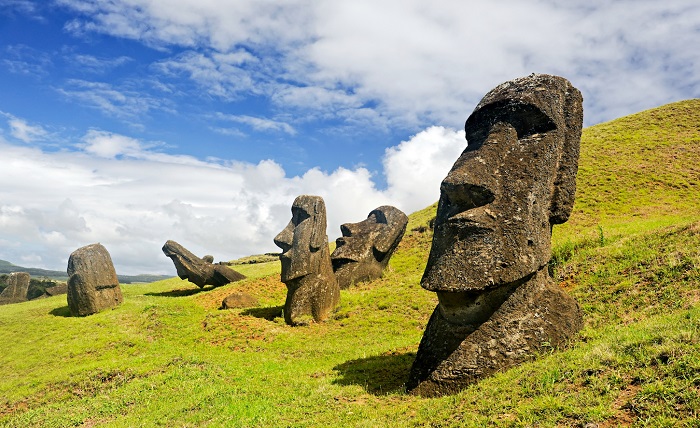Stone Heads: Ancient Art and Enigmatic Symbolism

Stone heads have fascinated mankind for centuries. From ancient civilizations to modern-day wonders, these enigmatic sculptures hold a certain allure that captures the imagination. In this comprehensive 2000-word blog post, we will delve into the intriguing world of stone heads. From their historical significance to their cultural symbolism, we will explore the mysteries surrounding these monumental sculptures.
Stone Heads
Stone heads have a rich and ancient history that dates back thousands of years. They can be found in various regions around the world, including Mesoamerica, Easter Island, and ancient Egypt. These sculptures were often created as tributes to gods, rulers, or deities, showcasing the skill and craftsmanship of the civilizations that created them.
Stone Head Locations Around
Stone heads can be found in diverse locations globally, each with its unique characteristics and cultural significance. Notable sites include Tres Zapotes in Mexico, Mount Nemrut in Turkey, and Rapa Nui (Easter Island) in the Pacific Ocean.
Factors to Consider for the Perfect Tour
When determining the best time to tour Stone Head, several factors come into play. These include weather conditions, crowd levels, availability of accommodations, and the natural environment’s aesthetics. By considering these factors, you can ensure an unforgettable journey to Stone Head.
Spring
As the winter frost melts away, spring breathes new life into the surroundings of Stone Head. The season of blossoming flowers and rejuvenated landscapes offers a unique experience to visitors.
Summer
Summer brings vibrant energy to Stone Head, attracting visitors from all over the world. It is a season of festivities, cultural celebrations, and extended daylight hours.
Autumn
Autumn paints Stone Head with an enchanting palette of warm colors. As the leaves change and the air turns crisp, the landscape surrounding Stone Head undergoes a breathtaking transformation.
Winter
Winter adds a touch of mysticism to Stone Head, transforming it into a winter wonderland. Although the temperatures drop, the beauty and serenity of the site remain intact.
The Cultural Significance of Stone Heads
Stone heads hold immense cultural significance for the societies that produced them. They represent power, authority, and the divine. In many cases, they served as symbols of religious worship, embodying the beliefs and values of the cultures that revered them. They often played a central role in rituals, ceremonies, and religious practices.
The Techniques Behind Stone Head Carvings
Carving stone heads requires great precision and skill. Ancient artisans employed various techniques, such as hammering, chiseling, and polishing, to bring these sculptures to life. Different cultures had their unique methods and tools, resulting in distinctive styles and artistic expressions.
Famous Stone Heads Around the World
Throughout history, numerous stone heads have gained worldwide recognition. The colossal stone heads of the Olmec civilization in Mesoamerica, the mysterious Moai statues of Easter Island, and the magnificent Sphinx in Egypt are just a few examples. These monumental sculptures continue to captivate visitors and researchers alike.
The Symbolism of Stone Heads
Stone heads are laden with symbolism. They can represent power, wisdom, protection, or ancestral lineage. Some stone heads feature intricate carvings and symbols that hold hidden meanings, requiring interpretation and analysis. The symbolism attached to these sculptures often reflects the cultural beliefs and ideologies of the societies that created them.
The Role of Stone Heads in Modern Art
Stone heads have left an indelible mark on the world of art. Countless contemporary artists draw inspiration from these ancient sculptures, incorporating their forms, textures, and symbolism into their works. Stone heads serve as a bridge between the past and the present, connecting generations through artistic expression.
Stone Heads as Guardians and Protectors
In many cultures, stone heads are believed to possess protective qualities. They are seen as guardians, warding off evil spirits or malevolent forces. Their imposing presence and watchful gazes instill a sense of security and reassurance in the communities that venerate them.
The Controversies Surrounding Stone Heads
The study and preservation of stone heads have not been without controversy. Ownership disputes, cultural appropriation concerns, and debates over repatriation have arisen due to the relocation of these sculptures to museums and institutions. These controversies highlight the complex ethical and cultural considerations involved in the preservation and display of stone heads.
Unraveling the Secrets of Stone Head Legends
Stone heads are often accompanied by legends and myths, shrouding them in an air of mystery. These stories, passed down through generations, offer different narratives about the origins and purpose of these sculptures. Researchers and archaeologists continue to investigate these legends, seeking to unveil the truth behind the enigmatic stone heads.
Stone Heads and Archaeological Discoveries
Stone heads have played a pivotal role in archaeological discoveries. They have led to the unearthing of ancient civilizations, revealing insights into their culture, beliefs, and practices. Through careful excavation and analysis, researchers have pieced together fragments of history, expanding our understanding of the societies that produced these magnificent sculptures.
The Influence of Stone Heads in Pop Culture
Stone heads have permeated popular culture in various forms. They have inspired books, movies, and artwork, serving as iconic symbols that evoke a sense of mystery and adventure. From archaeological thrillers to animated films, stone heads continue to captivate audiences and fuel the imagination.
Conservation Efforts for Stone Heads
Preserving stone heads for future generations requires dedicated conservation efforts. These sculptures are often subjected to environmental factors, vandalism, and natural decay. Organizations, researchers, and local communities work together to protect and restore these invaluable pieces of our collective heritage.
Tourist Attractions and Their Impact
Stone heads have become significant tourist attractions, drawing visitors from around the world. The influx of tourists brings economic benefits to local communities but also poses challenges in terms of conservation, overcrowding, and maintaining the cultural integrity of these sites. Sustainable tourism practices and responsible visitor management are essential to strike a balance.
The Psychological Fascination with Stone Heads
The allure of stone heads extends beyond their historical and cultural significance. Psychologically, they evoke a sense of awe, wonder, and curiosity. Their imposing size, mysterious origins, and intricate craftsmanship tap into our innate fascination with the unknown, sparking contemplation and introspection.
The Future of Stone Head Studies
As technology advances and research methods evolve, the future of stone head studies holds great promise. Non-invasive techniques, such as 3D scanning and digital modeling, allow for detailed analysis and documentation without damaging the sculptures. These advancements will undoubtedly shed new light on the secrets and mysteries still hidden within stone heads.
Conclusion
Stone heads continue to bewitch and inspire us. From their ancient origins to their enduring cultural significance, these sculptures embody the creativity, beliefs, and achievements of past civilizations. As we unravel their mysteries, let us ensure their preservation and appreciation for generations to come.





